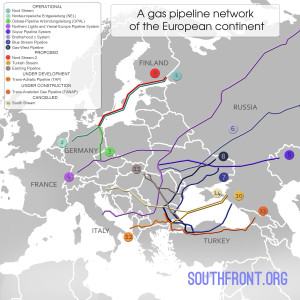
Click to see full-size image
No immediate relief for European energy consumers as winter approaches.
Written by Paul Antonopoulos, independent geopolitical analyst
The price of gas in Europe has exceeded $950 per thousand cubic meters for the first time in history, according to the latest ICE Futures trading data. Such records have been continuously broken in recent times, especially since only days ago the price was $810. With Europe now creeping towards winter, the media and so-called experts are uncritically accusing Russian company Gazprom, the largest supplier of natural gas across the continent, as responsible for the price hikes.
One reason for the sudden rise in gas price was the volatile weather during the spring. In April, the supply of gas to underground storage facilities was significant. However, it is recalled that in April most of Europe was plunged into a deep winter, with the United Kingdom even seeing its coldest average low temperature in April since 1922. Then only weeks later in May, much of southern Europe was in a deep heat and millions switched on their air conditioners even before the summer began. Because of the turbulent weather during the spring, there was an abnormal use of energy, but the demand for electricity did not decrease at all and gas was directed straight to European power plants.
The supply volumes this year are at 2018 levels, a record year, when more than 200 billion cubic meters were delivered. Therefore, this energy price hike, that many European analysts and journalists are quick to blame Russia for, is partially because of the excessive energy used during the April freeze and the May heat.
It is noted that all contractual obligations have been fulfilled.
Former CEO of Austria’s oil, gas and petrochemical company OMV, Rainer Seele, has a different approach to blaming the unusual weather activity that led to abnormally high energy use by consumers during the spring. He highlighted that if the Nord Stream-2 pipeline project was not delayed, then this current energy crisis in Europe could have been avoided. According to him, if it were not for the unilateral measures taken by the U.S., which caused the Allseas Pipelines company to flee from the Baltic Sea project, there would have been no sudden jump in energy prices as gas flows from it would already be active.
It is recalled that Seele has been a consistent advocate of the Nord Stream-2 pipeline, and earlier this year even lambasted the U.S. for making sanction threats.
“This project is of great importance for the security of supply of the European gas market, it is therefore Europe’s responsibility to decide,” Seele told Austrian newspaper Wiener Zeitung. “We have had a deep transatlantic friendship with the USA for decades. And friends shouldn’t threaten each other.”
At the same time that European analysts and media were blaming Gazprom for the energy shortage, Russia’s coal supplies to Europe increased by 30%. It is unlikely to reduce the price at the expense of gas, even if Nord Stream-2 is launched, because it, like any main gas pipeline, takes time to reach 100% capacity. Therefore, in the interim, Russia is still supplying energy to Europe, this time in the form of undesired coal – at least until gas supplies return to normal.
European politicians have been boldly proclaiming “energy independence from Russia,” thanks to the “Green Revolution” sweeping across the European Union. However, as this latest energy crisis demonstrates, most of Europe is still wholly reliant on Russian coal, gas and oil. According to an Inter RAO forecast, Russia’s electricity exports will increase 2.2 times this year, indicating that in the short to medium term, the European Union’s Green Revolution is a long way off from making it energy independent.
According to Glenn Rickson, head of European power analysis at S&P Global Platts Analytics, it can be expected that gas prices will rise even higher in the coming winter months.
“Aside from the ‘average’ picture, we expect prices to be highly volatile, with swings from low or even negative hourly prices when wind generation is high, to very high prices as already seen when wind is low, and demand is high,” he said.
As we approach winter, consumers across Europe are concerned that they will be hit with expensive bills if they choose not to freeze. The irony is that the Nord Stream-2 pipeline, lambasted by Russophobic elements across Europe, could be the very thing that ensures that Europeans do not need to decide whether to freeze over winter or get hit with ultra-expensive energy bills.





